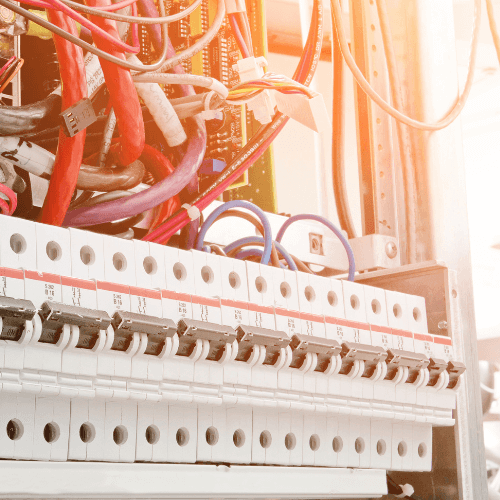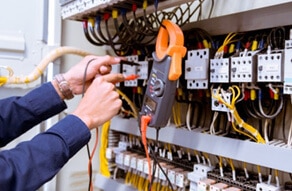Call us now
0439 823 190What Is The Difference Between RCD Switches and Circuit Breakers?
Posted on March 27, 2021

The main differences between RCD switches and circuit breakers are what they exactly protect. RCD switches mainly focus on preventing a person from receiving an electrical shock. Circuit breakers are designed to stop appliances and systems from being damaged by electrical surges. Here at The Local Electrician, our Emergency Electrician team is here to work on RCD switches and circuit breakers very frequently.
The difference between RCD switches and circuit breakers are if they protect people or electrical equipment. RCD switches will turn off the electricity supply when a current leak is detected to protect people from electrical shocks. Circuit breakers will cut off electrical power to specific circuits when an overload is detected to protect the appliances on the circuit. To prevent electrical accidents and the risk of electric shocks or fires these systems need to be installed.
What are RCD Switches?
Residual current devices are designed to protect people from being shocked caused by electrical overloads or surges. They will switch off the electrical power in milliseconds when there has been a current leak. This leak is prevented from flowing into a person as the electrical supply is shut off almost immediately.
What are the Different Types of RCD Switches?
There are three main types of RCD protection switches that can be installed for electrical safety:
- Electrical Switchboard – the electrical switchboard is the most common place for RCD switches to be installed. These are connected alongside other protective devices on the power distribution board.
- Portable – if a person is working with a tool or equipment which is not protected by an RCD then a portable one is an option. The individual can connect the appliance to the portable switch through an extension lead. This will be used to protect themselves and reduce the risk of them receiving a shock.
- Powerpoint – in workshops or bathrooms where the flow of electricity is either high or can be dangerous that RCD switches can be fitted into specific powerpoints. They will constantly detect the electrical current for any appliance connected to the power point.
RCD switches will need a fully qualified electrician to correctly install and connect them. Our electricians are highly trained to install any type of RCD switch, test them and ensure they are protecting people properly.
How Can I Test RCD Switches?
Testing the RCD switch is highly advised to ensure they are known to be working and protecting people. The best ways to test an RCD switch is to:
- Locate where the RCD switch is
- Turn off all electrical systems around the building
- When the power is off press the ‘test’ button
- Inspect to see if any systems or appliances are not working when the test button has been pressed
- Turn the RCD switch back on after every system has been tested
For more detailed steps on how to test an RCD switch, we strongly recommend reading our blog with further methods.
What are Circuit Breakers?
Circuit breakers look over specific electrical systems and circuits of a building. They will protect the devices, appliances and systems which are connected to the specific circuit. Electrical overloading is where there is too much power running through currents and can cause devices to be damaged. Circuit breakers will detect when there is too much electrical current in the circuit and switch off the power.
What are Some Signs that there is an Electrical Overload?
To know if there has been an electrical overloading incident look out for these signs:
- The circuit breaker inside the switchboard has been tripped with the switch flipped
- Lights dimmer more frequently when more appliances are in use
- Outlets, power points and switches buzz, are warm or have a strange odour
- Appliances, devices and tools are not working correctly or are not as powerful
When these issues are noticed then the chance that the circuit might overload is high and an emergency electrician should be contacted to inspect the problem. Our electrical repairs and electrical safety inspection services can ensure that electrical overloads and circuit breakers are controlled by one of our professional electricians.
What do I do When the Circuit Breaker has Tripped?
The main steps to follow then the circuit breaker has tripped and to keep people and appliances safe are to follow these steps:
- Locate the circuit breakers which are often inside the main electrical switchboard
- Identify what exact circuit breaker has tripped and what electrical circuit it controls
- Ensure that lights, appliances and devices are switched off if they are connected to the tripped circuit
- Turn the switch of the circuit breaker into the on position after every appliance has been turned off
- Test to see that the lights and electrical equipment which are connected to the tripped circuit breaker work
To know more about what to do when circuit breakers trip, we strongly encourage checking out our blog article.
Reliable and Trusted RCD Switch and Circuit Breaker Electricians
The Local Electrician offers our professional electricians to the locals of Sydney to work on RCD Switches and circuit breakers. We are able to install these systems into properties and connect them to the specific circuits. Each electrician will also repair and inspect them if they have tripped, been damaged or need a general safety test.
We operate on RCD switches and circuit breakers across all suburbs, from North Shore to South Sydney. Our Level 2 Electrician team is here for all locals when needing professional level 2 asp workers to carry out any advanced task.

For affordable, trusted and expert RCD switches and circuit breakers services – contact The Local Electrician on 0439 823 190!
Lifetime Warranty on Workmanship and Labor
Our Services
Our skilled electricians are qualified to carry out any electrical repair or installation within Sydney. We strive to deliver absolute customer satisfaction by offering electrical services that are affordable, safe and long lasting.
- Private Power Pole Installation: What Sydney Homeowners Need To Know - November 29, 2023
- Understanding Power Outages: When To Call a Level 2 Electrician - November 14, 2023
- Understanding Level 2 Electrical Needs: FAQs for Sydney Homeowners - October 7, 2023
Our Level 2 Local Electrical Services










